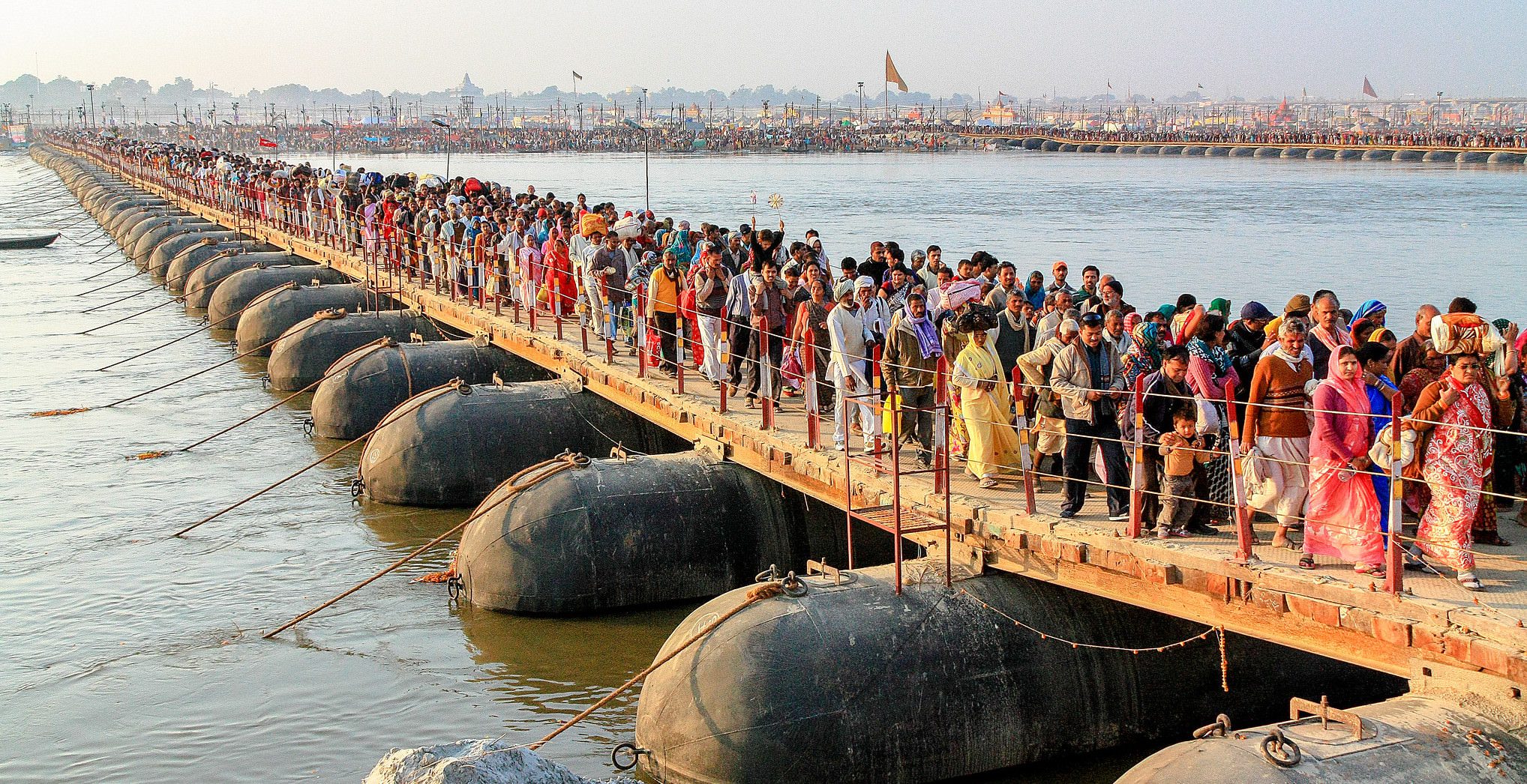
Pilgrims journey to the Maha Kumbh Mela. Pexels image by AlGraChe.
“Mythological significance of Kumbh revolves around the story of the Samudra Manthan (ocean churning) which was done by the gods and demons to obtain the invaluable ratnas or the jewels and amrita or the nectar of immortality. The churning released many things from the ocean – goddesses, supernatural animals and weapons, gems and treasures, among other things – which were all shared between the gods and the demons. Finally, the ocean gave up the treasure that the two sides so desperately sought. From the depths rose Dhanavantari, the divine physician of the gods, holding a pitcher (a kumbh) of amrit. Divine eagle ‘Garuda’ flew off with the pitcher to keep it from getting into the hands of the demons. As he flew, four drops of nectar from the pitcher fell to the earth. The places where these fell, all of which happen to be in northern India, are the sites of the various Kumbh Melas.
The Kumbh Mela is held once in 12 years at each of the four places and is attended by millions of pilgrims. It is believed that all moral impurities, even the most heinous ones, get completely washed away by bathing at the Kumbh. The exact dates of the Mela are determined according to a combination of zodiac positions of the planet Jupiter, the Sun and the Moon.”
– Sujata Saunik, excerpted from “Deconstructing the Kumbh Mela: Nashik-Timbakeshwar 2015”
Sujata Saunik, former Mittal Institute Research Affiliate and current Additional Chief Secretary of the Government of Maharashtra, spoke with the Mittal Institute about her new book, “Deconstructing the Kumbh Mela: Nashik-Trimbakeshwar 2015 – A Public Health Perspective,” which details some of the underpinings of planning the Kumbh Mela. She was the Principal Health Secretary during the 2015 Kumbh Mela, and in the book documents the detailed planning, preparedness and foresight necessary to plan an event of such magnitude. Sujata says the book is a celebration of the zeal of the entire workforce that is involved in the event, and she shares her experience in the interview that follows.
Mittal Institute: Sujata, thank you so much for speaking with us about your book. You have a decade of experience in disaster management and public health. Can you share a bit about your background, including your role during the 2015 Kumbh Mela?
Sujata Saunik: I am a civil servant with over three decades of public policy and governance experience in healthcare, finance, education, disaster management, and peacekeeping at the district, state, and federal levels and in international organizations as part of the Indian Administrative Service and the United Nations.
I have experience with leading the second largest public health department in India as a Principal Secretary, where I was responsible for building partnerships with key stakeholders, such as academia, civil society, and UN agencies.

Sujata Saunik, former Mittal Institute Research Affiliate and current Additional Chief Secretary of the Government of Maharashtra.
I have also worked as an Advisor and Joint Secretary with the National Disaster Management Authority (NDMA), Government of India. I assisted several departments and state governments in developing disaster risk reduction and management plans, training and international deployment of National Disaster Response Force (NDRF) and setting up state disaster response forces in the country
I was responsible for the planning, organizing and implementation of the Kumbh Mela, particularly from the public health perspective. I worked with multiple stakeholders in implementing projects to track the spread of diseases and incidences of public health outbreaks during the event.
Mittal Institute: Can you describe some of the challenges and opportunities in planning such a major event?
Sujata Saunik: The Kumbh Mela is one of the largest peaceful gatherings in the world and is considered the world’s largest congregation of religious pilgrims. To put things in perspective, the crowd density in Nashik (where the Kumbh Mela 2015 was organized) during the mega event is akin to cramming three times the population of New York City into one-sixth of its space.
There were several challenges, mainly to coordinate with multiple departments to ensure the experience is fruitful and, most importantly, free from any casualty for millions of visitors who congregate over a period of three months during the peak monsoon season. One has to plan and prepare for outbreak of diarrhea, other infections and waterborne diseases, crowd management and prevention of stampede, fire outbreak, freak accidents etc.
Coordination with multiple stakeholders, departments and agencies also posed challenges in ease of communication, both oral and written, and bringing everyone up to speed on the decisions being taken for effective implementation. And lastly, keeping the citizens updated on the facilities being set up through an informed media.

A bathing ritual during the Kumbh Mela. Pexels image by Water Alternatives.
Mittal Institute: In your book, you talk about some of the new initiatives that were implemented, including creating “no selfie zones” and combatting “fake news” on the fly. Can you describe how this on-your-feet-thinking was critical to the success of Kumbh Mela?
Sujata Saunik: We found that selfies had the potential to trigger stampedes. As a result, the local administration declared some key areas at the bathing ghats as, “No Selfie Zones.” This helped in minimizing the risk of any stampede, freak accidents etc. Refer to section two – chapter eight (page 182)
We also came across incidences of fake news being spread by some miscreants. Considering the high penetration of social media and its ability to propagate content in a short time frame, we were continuously monitoring fake news and combatting them with factual information. This significantly helped in conducting the event smoothly. Refer to appendix three – media management (page 364)

A pilgrim prays. A Pexels photo by AlGraChe.

Hindu pilgrims heading to the Kumbh Mela site. Image by Stuti.

Water dip at the Kumbh festival. Image by Vitthal Jondhale.
Mittal Institute: You and your colleagues also used an application called EMCounter to collect data on footfalls and disease patterns. Can you explain how you gathered such data, and how you applied your findings?
Sujata Saunik: EMCounter is a real-time digital disease surveillance system. The system was launched as a public-private initiative between the Public Health Department of the Government of Maharashtra and Harvard Mittal Instiute (previously the South Asia Institute), and partners in the USA and India, like UNICEF Mumbai.
EMcounter was implemented at 39 health clinics. The local teams deployed at Nashik, along with the Harvard team led by Dr. Satchit Balsari from Chan School of Public Health, used 50 computer tablets to feed in data. Around 100 doctors gathered information (patient’s name, age, gender and chief complaint) from patients. The information was fed into a mobile-based system and real-time information was displayed on the dynamic dashboard. The tablets and EMcounter were connected with a centralized real-time data processing and management system.
These analytics provided an easy-to-use interface that allowed policymakers and administrators to directly query incoming data in real-time. The Public Health Department of the state used real-time analytics to match inventory and personnel with demand. Access to real-time epidemiological data triggered the deployment of sanitation teams to successfully investigate water-borne outbreaks. Refer to section four – chapter two (page 281-285)
Mittal Institute: You also created structures for the pilgrims, which you describe in your book. Can you share more about these structures – their intended purpose and the thought-process behind their construction?
Sujata Saunik: The Kumbh Mela is organized every 12 years; hence, setting up permanent structures is not possible and it is calls for building many temporary ones. This made arranging the Kumbh in Nashik all the more challenging compared to several other mega events hosted around the world, such as the Haj, which is an annual event, so a lot of the structures set up are permanent. The rest of the Indian states where the Kumbh melas are held also have a permanent set-up devoted to the festival. To accommodate the millions of pilgrims in Nashik, a temporary city called Sadhugram was built which had all the basic facilities required for human habitation, such as clean water, electricity, medical centers, etc. In 2015, nearly 297,000 ascetics stayed in Sadhugram. Refer to section two – chapter one (page 62)
Other structures that were put in place were public amenities and resting places. Bathing ghats are ground zero of the Kumbh. Devotees congregate on these ghats to take the ritualistic dips at appointed times of the day and evening. The second set of structures are for people to rest at night and have access to toilet and food facilities. The third set is for providing the connectivity to the ghats via lanes and roads, including public amenities and parking facilities. Health clinics, which were designed on standard pattern for easy access, were another important segment. It is almost like another city being set up for three months to house the inflow of the pilgrims to the main city.

Large crowds at the Ganga (Ganges) on a major bathing day in the 2019 Kumbh Mela. Image by Michael T Balonek.
Mittal Institute: The book shares some best practices for designing and managing large-scale events. What are some pieces of advice that you gleaned from your experience that you might share with other governmental organizations?
Sujata Saunik: Based on our own experience, we have, as a team, prepared a Standard Operating Procedure (SOP), which, hopefully, can apply to any scenario where people are tasked with hosting of a mega event. The main underpinning is public health – how preventive measures can help avoid loss of lives, injuries and other life-saving techniques that we tested at the Kumbh. This SOP is a dynamic document in which we have also included protocols to be followed for a pandemic or epidemic. Hopefully we shall receive feedback and suggestions for improvements from people who have organized events of similar nature and scale from around the world. Refer to section five – ‘Standard Operating Procedure (SOP)’ (page 322)


Kumbh Melas feature many trade, fairs, charity, community singing, religious recitations, and entertainment spectacles. Left: Anna Dāna event at Prayag Kumbh, feeding monks and poor; Right: A dance performance. Images by Ninara.
Mittal Institute: What are you most proud of from your involvement in Kumbh Mela? What will you remember the most?
Sujata Saunik: One of the biggest achievements was that we did not have any casualties attributed to public health measures. Apart from this, innovative ideas such as the Green Kumbh, implementation of digital surveillance system, and combating fake news have also been significant achievements.
